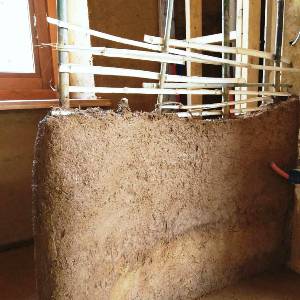Hybrid Natural Building Materials
- Sigi Koko
- Dec 19, 2024
- 3 min read
Most natural building methods are actual a combination of materials
Like a stew. Each chosen from what is available locally and used for its particular characteristics.
Materials that trap air pockets where insulation is required.
Sticky materials where a binding glue is needed.
Sand to control shrinking or increase compressive strength.
Fibrous ingredients when you need to knit materials together.
woven bamboo lattice (wattle) with clay/straw (daub) | completed wattle & daub wall with clay plaster finish |
Most hybrid natural materials are made up one of two or more of the following (hence the term "hybrid"):
Clay - super sticky binder used in a variety of natural materials
Sand - aggregate added to increase strength and reduce shrinkage & cracking
Fiber - such as straw or hemp, provides insulation & knits materials together
Wood/Bamboo - ideal for structural supports, woven elements, or cordwood
Lime - binder used for wear-resistant plasters & paints
The idea is to look at what is available locally in nature in abundance. Then understand the performance qualities you need. Do you need insulation to stay warm in winter? Do you need mass to absorb heat? Do you just need a partition to separate spaces? Then select those local materials that will best accomplish those needs. Scroll below to see a breakdown of some of the most common hybrid natural materials and where to use them.
Best Use
Use hybrid walls where you need thinner, non-structural walls or to maximize the use of your local materials
Cheat Sheet | HYBRID MATERIALS COMBINE TWO OR MORE OF THE FOLLOWING: |
HYBRID MATERIALS COMBINE TWO OR MORE OF THE FOLLOWING: Clay - super sticky binder that creates internal structure for a variety of applications Sand - aggregate added to increase strength and reduce shrinkage & cracking Fiber - such as straw or hemp, provides insulation & knits clay materials together Wood/Bamboo - ideal for structural supports Lime - binder used for wear-resistant plasters & paints | AT A GLANCEmost hybrid materials combine fibrous ingredients (such as straw or hemp) with a natural binder (such as clay or lime)most hybrids are non-structural (except cordwood) BEST USEwhen you need to maximize the performance of various local materials LINK TO GLOSSARY |
Comparison of Hybrid Natural Wall Materials
quick look at various methods that use a hybrid of materials from nature
MATERIAL | DESCRIPTION | BEST USE | BENEFITS | CHALLENGES |
LIGHT CLAY | Light clay straw is made by coating straw fibers with liquid clay and tamping the mixture into a wall cavity. The clay glues the straw fibers together. to create a solid infill material. | Use where modest insulation or good sound absorption is a benefit | •excellent acoustic performance •simple installation •very inexpensive •prevents air leakage | •requires ample airflow during drying •requires cavity wall system (such as stud framing) •labor intensive •limited testing data |
HEMPCRETE | Hempcrete is a combination of hemp hurds (from woody hemp stalks) glued together with sticky lime. The mixture is tamped into a wall cavity and then plastered on both sides. | Use as insulation to save on heating & cooling, or where walls experience occasional wetting. | •high insulation •can handle some dampness •sequesters CO2 •regulates humidity •prevents air leakage | •lime binder is caustic during installation •requires cavity wall system (such as stud framing) •labor intensive •currently costly in USA |
CORDWOOD | Cordwood features logs, round or split, all cut to the same length. The logs are mortared together, with their length creating. the wall-width. | Use if you have wood in abundance and benefit from modest insulation | •modest insulation •no finish plastering required •uses short pieces of wood •logs create the wall surface aesthetic | •slow to build •logs must be cured (dried) to prevent shrinking in place •wood-intensive •pointing between logs can be tricky |
WATTLE & DAUB | Wattle is woven material, used to create whatever shape you like (walls, shelves, fencing). Daub is a wet mixture of clay soil and plant fibers (such as straw). | Use as non-structural partitions where insulation is not required | •nearly free interior wall system •thin walls •simple, low-tech •intuitive | •non-structural •usually requires finish plaster •low thermal mass •non-insulating |
Recommended Reads
Here are my favorite books about hybrid construction techniques
(click the cover of the book to purchase)
The Hempcrete book: This is my number one book on hempcrete construction; it explains the science, the process, & the performance | The EcoNest Home: This book covers light clay straw construction, & includes inspirational photos, step-by-step photos, plus lots of construction details | Essential Cordwood Building: Practical guide to cordwood construction, including process & permitting | Cordwood Construction Best Practices: Another good resource on cordwood construction | Built by Hand: This book offers a trip around the world, highlighting a wide variety of indigenous buildings from every conceivable climate. |















